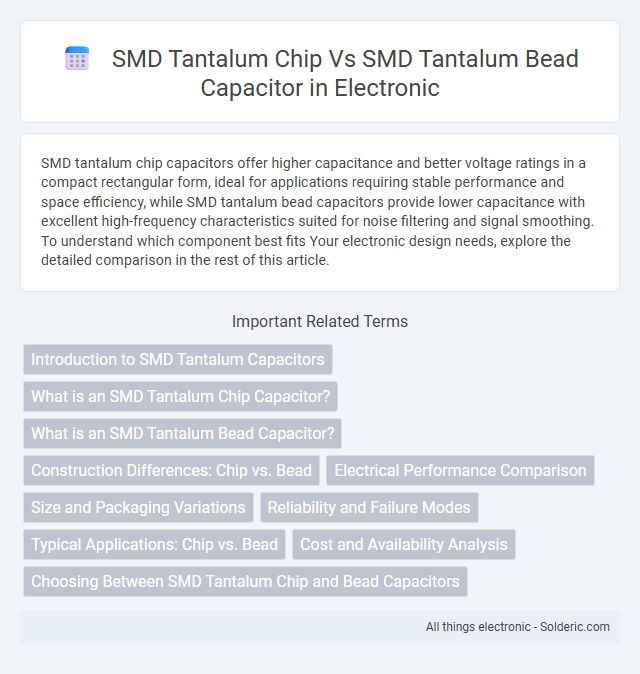SMD tantalum chip capacitors offer higher capacitance and better voltage ratings in a compact rectangular form, ideal for applications requiring stable performance and space efficiency, while SMD tantalum bead capacitors provide lower capacitance with excellent high-frequency characteristics suited for noise filtering and signal smoothing. To understand which component best fits Your electronic design needs, explore the detailed comparison in the rest of this article.
Comparison Table
| Feature | SMD Tantalum Chip Capacitor | SMD Tantalum Bead Capacitor |
|---|---|---|
| Shape | Rectangular Chip | Round Bead |
| Capacitance Range | 0.1 uF to 470 uF | 0.1 uF to 22 uF |
| Voltage Rating | 4V to 50V | 4V to 35V |
| Equivalent Series Resistance (ESR) | Low ESR | Higher ESR compared to chip |
| Applications | Decoupling, filtering in compact circuits | High-frequency circuits, general purpose filtering |
| Mounting Type | Surface Mount (SMT) | Surface Mount (SMT) |
| Reliability | Stable with low leakage current | Good, but slightly higher leakage than chips |
| Size | Smaller footprint | Larger footprint relative to capacitance |
Introduction to SMD Tantalum Capacitors
SMD tantalum capacitors are essential components in electronic circuits, available mainly as chip and bead types, each serving distinct functions. Chip capacitors offer high capacitance in a compact surface-mount package, ideal for decoupling and filtering applications, while bead capacitors primarily provide noise suppression and transient voltage protection. Understanding the differences in construction, capacitance range, and application suitability is crucial for optimizing electronic circuit performance.
What is an SMD Tantalum Chip Capacitor?
An SMD tantalum chip capacitor is a surface-mount device designed for compact electronic circuits, offering high capacitance in a small footprint. It uses tantalum as the anode material, providing excellent stability, reliability, and low equivalent series resistance (ESR), ideal for decoupling and filtering applications. Your choice of an SMD tantalum chip capacitor ensures improved performance in power supply circuits compared to SMD tantalum bead capacitors, which are primarily used for EMI suppression rather than energy storage.
What is an SMD Tantalum Bead Capacitor?
An SMD tantalum bead capacitor is a surface-mount device designed for high-capacitance, low-inductance applications in compact electronic circuits. Unlike the flat, rectangular SMD tantalum chip capacitor, the bead capacitor features a small, rounded shape that allows for superior vibration resistance and stability under thermal stress. Your choice between these capacitors depends on size constraints, frequency response, and mechanical durability required for the specific electronic design.
Construction Differences: Chip vs. Bead
SMD tantalum chip capacitors are constructed with a flat, rectangular shape featuring layered anode and cathode materials, providing high capacitance in a compact form ideal for surface mounting. In contrast, SMD tantalum bead capacitors have a spherical or bead-like shape with a molded epoxy coating, focusing on robust mechanical strength and low inductance for high-frequency applications. Understanding these construction differences can help you select the right component based on size constraints and performance requirements.
Electrical Performance Comparison
SMD tantalum chip capacitors exhibit lower Equivalent Series Resistance (ESR) and higher capacitance stability compared to SMD tantalum bead capacitors, resulting in better performance under high-frequency and high-current conditions. The chip design supports improved thermal management and reduced inductance, enhancing overall signal integrity in sensitive electronic circuits. Conversely, tantalum bead capacitors generally offer more ruggedness and pulse tolerance but compromise on ESR and capacitance precision.
Size and Packaging Variations
SMD tantalum chip capacitors typically offer smaller, rectangular packages with standardized sizes such as 3216 or 4763, making them ideal for high-density PCB layouts. In contrast, SMD tantalum bead capacitors have a bead-like cylindrical shape, generally larger in size and suited for applications requiring higher capacitance or voltage ratings. Your choice between these capacitor types should consider the available board space and specific packaging constraints of your electronic design.
Reliability and Failure Modes
SMD tantalum chip capacitors exhibit higher reliability due to their solid manganese dioxide or polymer cathode construction, which minimizes degradation and leakage compared to SMD tantalum bead capacitors. Failure modes in tantalum chip capacitors often involve dielectric breakdown caused by voltage spikes or excessive surge currents, whereas tantalum bead capacitors are more prone to failures from mechanical stress and micro-cracks due to their bead-like structure. The chip design also offers better heat dissipation and stability under high-frequency operation, enhancing overall performance and longevity in demanding electronic applications.
Typical Applications: Chip vs. Bead
SMD tantalum chip capacitors are typically used in high-frequency filtering, decoupling, and energy storage in compact electronic circuits such as smartphones, laptops, and automotive electronics. SMD tantalum bead capacitors excel in electromagnetic interference (EMI) suppression and noise reduction in power supply lines and signal conditioning circuits within telecommunications and industrial equipment. The chip variant offers higher capacitance density suitable for miniaturization, while the bead type provides superior inductive properties for transient voltage spike mitigation.
Cost and Availability Analysis
SMD tantalum chip capacitors typically offer lower cost per unit and higher availability due to widespread manufacturing and standardized sizes. SMD tantalum bead capacitors, while offering specific electrical characteristics, tend to be more specialized and thus less commonly stocked, resulting in higher prices and limited supply. Your choice between the two will depend on balancing budget constraints with design requirements and component accessibility.
Choosing Between SMD Tantalum Chip and Bead Capacitors
Choosing between SMD tantalum chip and bead capacitors depends on your circuit requirements such as size, capacitance, and frequency response. SMD tantalum chip capacitors offer higher capacitance values and stable performance in compact designs, while tantalum bead capacitors excel in EMI suppression and high-frequency filtering. Understanding your specific application needs will help you select the optimal capacitor for improved circuit reliability and efficiency.
SMD tantalum chip vs SMD tantalum bead capacitor Infographic

 solderic.com
solderic.com